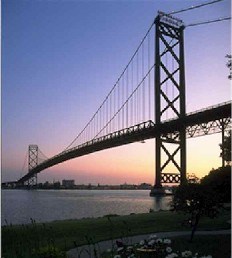NEWS RELEASE
MICHIGAN DEPARTMENT| OF TRANSPORTATION
************************* Federal government approves new Detroit-Windsor border crossing system January 15, 2009 - The federal government yesterday issued a long-awaited decision approving a new Detroit-Windsor border crossing system over the Detroit River.
The Record of Decision, issued January 14, by the Federal Highway Administration (FHWA), is the final environmental clearance for the Detroit River International Crossing (DRIC) Study for a proposed new border crossing system just north of Zug Island.
The Record of Decision is the last step under the National Environmental Policy Act (NEPA) to gain project approval, following four years of consultations, public hearings, traffic analyses and environmental studies.
The Record of Decision allows Michigan to begin right-of-way acquisition and construction planning for the proposed new bridge [shown is existing Ambassador Bridge].
Construction of a new border inspection plaza, bridge and interchange is scheduled to begin in 2010, with an official opening of the new crossing system planned for 2013.
"The new border crossing system empowers Michigan's economic recovery and revitalization as evidenced by the broad business community support for the project," said Governor Jennifer M. Granholm. "In addition to fueling our economic engine and creating jobs, an expanded Detroit-Windsor border crossing system will benefit every traveler who relies on safe, efficient border crossings."
"This is a significant milestone," said State Transportation Director Kirk T. Steudle. "Once built, the new crossing system will boost U.S. and Canadian trade by expanding the busiest trade corridor in the western hemisphere. Activity on the Michigan side of the border will create 10,000 construction jobs and more than 30,000 indirect jobs during the construction period. This project is needed to transition the border crossing into a modern, multimodal network to securely move people and goods between the United States and Canada and make Southeast Michigan an even more prominent gateway for global commerce. We will be building the most modern border crossing system in the world."
"This great news could not come at a better time. Construction of this new crossing will be a huge stimulus to our sagging economy. The green light has been turned on. Let's get going," said Oakland County Executive L. Brooks Patterson.
"This is great news. We not only supported this initiative, but we stand ready to work closely with MDOT and Canadian government officials to build the economic future for our region," said Richard Blouse, Jr., president and CEO of the Detroit Regional Chamber. "We believe an additional crossing between the U.S. and Canada will enhance our regional positioning as a logistics hub, and assist in our strategy to create new jobs and entrepreneurial opportunity."
"This is the busiest trade corridor in the United States," said Mike Johnston, vice president of governmental affairs, Michigan Manufacturers Association. "This expansion is vital to existing Michigan manufacturers and will be significant for Michigan's economic vitality."
"Ford Motor Company is encouraged by the federal government's decision to approve a new crossing," said Pamela Stec, director of North American materials planning and logistics, Ford Motor Company. "The new crossing should relieve the periodic congestion we experience at the current Detroit/Windsor gateway and enable a timely and uninterrupted flow of materials and vehicles across the U.S./Canadian border, which will be good for Ford Motor Company, our suppliers, dealers and customers."
The DRIC Study, a binational effort, was led by the Border Transportation Partnership, comprised of the FHWA, Transport Canada, MDOT and the Ontario Ministry of Transportation.
The Border Transportation Partnership was formed in 2000 to provide for the safe, efficient and secure movement of people and goods across the U.S.-Canada border at the Detroit River to support the regional, state, provincial and national economies, and meet the civil and national defense and homeland security needs of the busiest trade corridor between the United States and Canada.
More information about the DRIC, including the Record of Decision, is available on the Border Transportation Partnership website.
*************************
